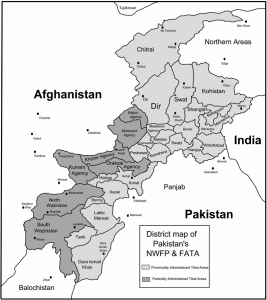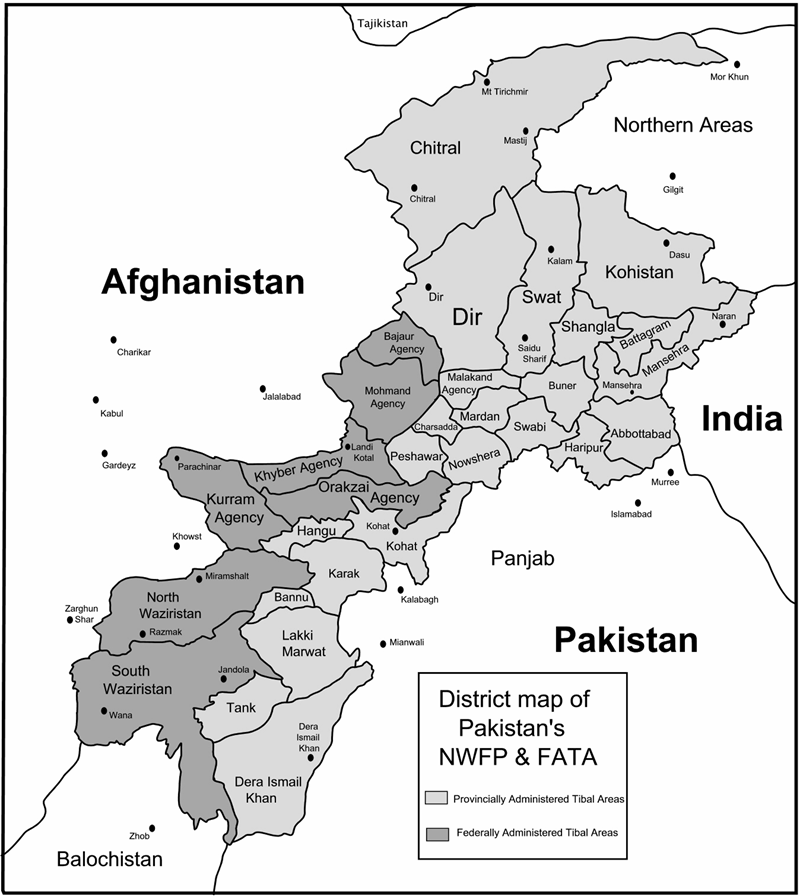
Over time the Taliban murdered hundreds of maliks (tribal landlords) in FATA, accused of spying for Pakistan, beheaded drug peddlers, kidnappers, looters and dacoits and collected jazihya (taxes on non-Muslims) to establish their rule. It would change the traditional social structure and hierarchy and cause an exodus of landlords, political agents and secular communities to Khyber Pakhtunkhwa’s settled areas.
In Khyber agency, the main artery connecting Peshawar to Kabul, a running battle between two religious groups – led by Mufti Munir Shakir and an Afghan, Pir Saifur Rehman – in 2005 resulted in a heavy loss of life. Shakir’s group spawned the Lashkar-i-Islam (Army of Islam), whose leader Mangal Bagh used FM radio stations in the madressahs (Islamic schools) of the tribal belt to incite listeners into acts of sectarian violence against the local Shia population. From time to time, they blew up transmission towers of FM radio stations to stop the government from broadcasting music and information.
While the government encouraged the predominantly Shia population of the surrounding Kurram agencies to form tribal armies – or lashkars – for self-protection, the militants responded by suicide missions that included ramming explosive laden vehicles into jirgas (tribal councils). These militants banded under the ASSP and LEJ also found ways to attack Shia refugees and their congregations in prayer houses and mourning processions that stretched all the way from Khyber to Karachi.
Although Shias did not turn against Sunnis on a large scale, as has been the case in Iraq, these attacks led to steady stream of retaliation. Where the military took on the Taliban, their sectarian affiliates responded with growing attacks on non-Muslims, surpassing the sectarian violence witnessed two decades ago.
As the Bush administration mounted pressure on Pakistan to “do more,” in the “War on Terror,” Pakistan’s army soldiers came in the front line of fire. Being poorly equipped and trained, the conventional army was no match for the well-armed Taliban who fought with guerrilla tactics that included improvised explosive devices (IEDs), suicide attacks, kidnappings and beheadings. It led to situations in which entire contingents of soldiers were kidnapped and several were beheaded. Others were either forced to surrender or voluntarily deserted the army.
In 2006, matters reached a point where Musharraf was forced to make a deal with Taliban militant Hafiz Gul Bahadur in North Waziristan that his tribesmen would expel foreign fighters from the tribal belt and refrain from attacking the Pakistan military in return for the administration’s movement of 80,000 troops from check posts in Waziristan to the Afghan border. The deal succeeded in getting rid of Uzbek fighters – subsequently leading to the assassination of their chief, Tahir Yuldeshev, through a drone attack.
But the North Waziristan peace deal would eventually turn the area into the last refuge for jihadists. As late as 2010, Awami National Party Senator, Afrasiab Khattak admitted to me that Gul Bahadur’s forces had become a “problem” for his government.
Meanwhile, tribesmen were eyewitnesses to the return of Afghan Mujahideen commander Jalaluddin Haqqani and Gulbuddin Hekmatyar in North Waziristan. In December 2009, these former CIA-funded Mujahideen gave sanctuary to a Jordanian double agent who used suicide bombing to wipe out a sizeable portion of US intelligence officials who were posted at Khost, Afghanistan.
Former FATA security chief Brig Mahmood Shah, who quit his position in 2005, calls the North Waziristan accord “a bad deal” that enabled the Taliban to consolidate its position. While initially the Afghan Taliban did expel foreign fighters from the region, soon it was back to square one as the Haqqani network attracted foreign jihadists and launched increasingly daring attacks against NATO forces in Afghanistan.


Great knowledge! I have been looking for anything like this for some time these days. Thanks!